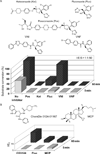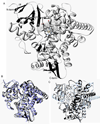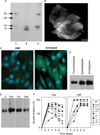Targeting Trypanosoma cruzi sterol 14α-demethylase (CYP51)
- PMID: 21820552
- PMCID: PMC3488290
- DOI: 10.1016/B978-0-12-385863-4.00004-6
Targeting Trypanosoma cruzi sterol 14α-demethylase (CYP51)
Abstract
There are at least two obvious features that must be considered upon targeting specific metabolic pathways/enzymes for drug development: the pathway must be essential and the enzyme must allow the design of pharmacologically useful inhibitors. Here, we describe Trypanosoma cruzi sterol 14α-demethylase as a promising target for anti-Chagasic chemotherapy. The use of anti-fungal azoles, which block sterol biosynthesis and therefore membrane formation in fungi, against the protozoan parasite has turned out to be highly successful: a broad spectrum anti-fungal drug, the triazole compound posaconazole, is now entering phase II clinical trials for treatment of Chagas disease. This review summarizes comparative information on anti-fungal azoles and novel inhibitory scaffolds selective for Trypanosomatidae sterol 14α-demethylase through the lens of recent structure/functional characterization of the target enzyme. We believe our studies open wide opportunities for rational design of novel, pathogen-specific and therefore more potent and efficient anti-trypanosomal drugs.
Copyright © 2011 Elsevier Ltd. All rights reserved.
Figures







Similar articles
-
Antitrypanosomal Activity of Sterol 14α-Demethylase (CYP51) Inhibitors VNI and VFV in the Swiss Mouse Models of Chagas Disease Induced by the Trypanosoma cruzi Y Strain.Antimicrob Agents Chemother. 2017 Mar 24;61(4):e02098-16. doi: 10.1128/AAC.02098-16. Print 2017 Apr. Antimicrob Agents Chemother. 2017. PMID: 28167559 Free PMC article.
-
Complexes of Trypanosoma cruzi sterol 14α-demethylase (CYP51) with two pyridine-based drug candidates for Chagas disease: structural basis for pathogen selectivity.J Biol Chem. 2013 Nov 1;288(44):31602-15. doi: 10.1074/jbc.M113.497990. Epub 2013 Sep 18. J Biol Chem. 2013. PMID: 24047900 Free PMC article.
-
In vitro and in vivo studies of the antiparasitic activity of sterol 14α-demethylase (CYP51) inhibitor VNI against drug-resistant strains of Trypanosoma cruzi.Antimicrob Agents Chemother. 2013 Sep;57(9):4151-63. doi: 10.1128/AAC.00070-13. Epub 2013 Jun 17. Antimicrob Agents Chemother. 2013. PMID: 23774435 Free PMC article.
-
Sterol 14alpha-demethylase (CYP51) as a therapeutic target for human trypanosomiasis and leishmaniasis.Curr Top Med Chem. 2011;11(16):2060-71. doi: 10.2174/156802611796575902. Curr Top Med Chem. 2011. PMID: 21619513 Free PMC article. Review.
-
Sterol 14α-Demethylase from Trypanosomatidae Parasites as a Promising Target for Designing New Antiparasitic Agents.Curr Top Med Chem. 2021;21(21):1900-1921. doi: 10.2174/1568026621666210303144448. Curr Top Med Chem. 2021. PMID: 33655860 Review.
Cited by
-
Trypanosomatid comparative genomics: Contributions to the study of parasite biology and different parasitic diseases.Genet Mol Biol. 2012 Jan;35(1):1-17. doi: 10.1590/s1415-47572012005000008. Epub 2012 Jan 20. Genet Mol Biol. 2012. PMID: 22481868 Free PMC article.
-
3-pyridyl inhibitors with novel activity against Trypanosoma cruzi reveal in vitro profiles can aid prediction of putative cytochrome P450 inhibition.Sci Rep. 2018 Mar 20;8(1):4901. doi: 10.1038/s41598-018-22043-z. Sci Rep. 2018. PMID: 29559688 Free PMC article.
-
Glutamine metabolism modulates azole susceptibility in Trypanosoma cruzi amastigotes.Elife. 2020 Dec 1;9:e60226. doi: 10.7554/eLife.60226. Elife. 2020. PMID: 33258448 Free PMC article.
-
Development of a Fluorescence-based Trypanosoma cruzi CYP51 Inhibition Assay for Effective Compound Triaging in Drug Discovery Programmes for Chagas Disease.PLoS Negl Trop Dis. 2015 Sep 22;9(9):e0004014. doi: 10.1371/journal.pntd.0004014. eCollection 2015 Sep. PLoS Negl Trop Dis. 2015. PMID: 26394211 Free PMC article.
-
Progress and Prospects of Triazoles in Advanced Therapies for Parasitic Diseases.Trop Med Infect Dis. 2025 May 20;10(5):142. doi: 10.3390/tropicalmed10050142. Trop Med Infect Dis. 2025. PMID: 40423371 Free PMC article. Review.
References
-
- Aoyama Y, Yoshida Y, Sonoda Y, Sato Y. 7-Oxo-24,25-dihydrolanosterol: a novel lanosterol 14 alpha-demethylase (P-45014DM) inhibitor which blocks electron transfer to the oxyferro intermediate. Biochim. Biophys. Acta. 1987;922:270–277. - PubMed
-
- Apt W, Aguilera X, Arribada A, Perez C, Miranda C, Sanchez G, et al. Treatment of chronic Chagas’ disease with itraconazole and allopurinol. Am. J. Trop. Med. Hyg. 1998;59:133–138. - PubMed
-
- Araujo MS, Martins-Filho OA, Pereira ME, Brener Z. A combination of benznidazole and ketoconazole enhances efficacy of chemotherapy of experimental Chagas’ disease. J. Antimicrob. Chemother. 2000;45:819–824. - PubMed
-
- Beach DH, Goad LJ, Holz GG., Jr Effects of ketoconazole on sterol biosynthesis by Trypanosoma cruzi epimastigotes. Biochem. Biophys. Res. Commun. 1986;136:851–856. - PubMed
-
- Benveniste P. Sterol biosynthesis. Annu. Rev. Plant Physiol. Plant Mol. Biol. 1986;37:275–308.
Publication types
MeSH terms
Substances
Grants and funding
LinkOut - more resources
Full Text Sources

